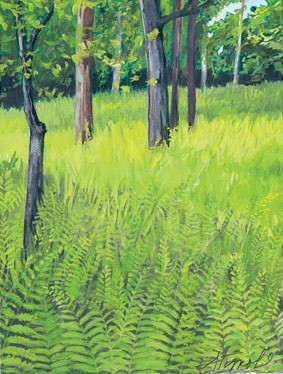
Wily, non-native plants that outperform native species and proceed to carpet the forest and field are all too familiar nowadays. Most of us have seen understories of European buckthorn or Eurasian honeysuckle species where normal tree regeneration doesn’t stand a chance. The wild chervil, garlic mustard, and wild parsnip introduced from Europe seem to have supernatural powers as they march across fields and meadows, eliminating native wildflowers and grasses. But keep your xenophobia in check: there are some native species, including the lovely hay-scented fern that, under certain conditions, form an extensive, persistent mat, doing a good imitation of the foreign invaders.
In moderation, hay-scented fern is a beautiful and harmless addition to the forest. It appreciates small openings, and its light green, lacy fronds shine as they align themselves to face the sun. This fern grows singly from underground stems, called rhizomes. Typically, it is about two feet high, but occasionally reaches twice that height. Crushed fronds have a scent that is even sweeter than new-mown hay.
Sometimes, usually when there is increased light in the understory from a thinning, powerline right-of-way maintenance, or damage from a windstorm, hay-scented fern takes over. It doesn’t happen overnight, but the branching rhizomes crank out frond after frond until they’ve formed an impenetrable mass. Because of its persistence, hay-scented fern will continue to dominate the understory long after a disturbance. By and large, insects are not interested in this fern; nor are any other herbivores. The patch spreads and spreads.
Beneath that solid carpet of hay-scented fern, light levels are so low that few tree seedlings are to be found. Seed predation is the first obstacle. In the safety of the tangle of dark stems, rodents are more abundant than in fern-free areas. It is so dark there that some of the tree seeds that escape being eaten are not motivated to germinate – and those that do face grim prospects. At typical sub-fern growth rates, a red oak seedling might emerge from the fern layer in ten years. By then, less than five percent of the original seedlings survive. A typical red maple seedling is expected to take 27 years to outgrow the ferns, at which time 0.6 percent of the seedlings are still alive. Another fern, New York fern, can also inhibit tree regeneration by forming dense mats.
Over the past 50-80 years there have been more and more reports of hay-scented fern interfering with regeneration. Over that same time, many parts of the Northeast have experienced a large increase in the deer population. An overabundant deer population has been present in Pennsylvania since the 1920s and in other states since the 1950s. Hay-scented fern is not on the whitetail’s menu, putting it at a competitive advantage over more palatable species such as sugar maple, red maple, white ash, and hemlock, especially where there are gaps in the canopy. The rare tree seedling that survives in a fern patch is likely to become rarer when deer are abundant.
Studies in Massachusetts forests, where deer were enclosed for a number of years at controlled densities, support the idea of blaming the deer. And after 40 years of intensive deer browsing in the Quabbin Reservoir forest, 4,000 hectares of the oak-pine forest had dense fern understories. Three years after the herd was markedly reduced through controlled hunting, a change in tree seedling survival was detected.
Another reason for hay-scented’s increase may be acid deposition. This fern proliferates in acidic soils, but many tree species, especially sugar maple, have the opposite reaction. As we know, soils have become increasingly acidic throughout the Northeast over the past 60 years. Research in Pennsylvania by William E. Sharpe and Jessica E. Halofsky convinced them that acidification far outweighs deer as cause of hay-scented fern’s increasing influence on forest regeneration.
Most ferns, including hay-scented, are easily knocked back by herbicides, but this is not a popular option. Repeated mowing, mechanical removal, and perhaps adding lime, can be effective, too, but these techniques are rarely feasible in a forest setting.
Although persistence might be a good middle name for hay-scented fern, there is a limit to it and time and shade will finally end fern’s dominance. As patch cuts slowly grow in from the edges, the fern is less robust, and struggling seedlings will begin to see the light.


Discussion *